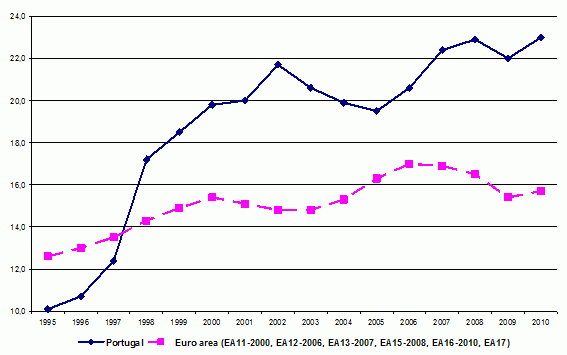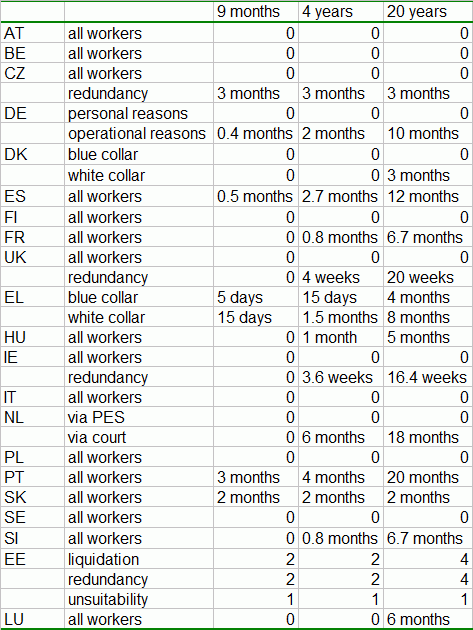Differences in the level of employment protection between open-ended and fixed-term contracts are often cited as one of the major causes of increasing labour-market segmentation in some European countries. This is especially true for young workers who have little chance of moving from temporary to permanent contracts.
Figure 1. Share of temporary employment on total employment
Note: age 15-64. Source: Eurostat, Labour Force Survey
In France, Italy, and Spain there have been debates on proposals for a single labour contract (Blanchard and Tirole 2003, Cahuc and Kramarz 2004, Boeri and Garibaldi 2008, Andrés et al. 2009).1 Although the single contracts discussed in the debate are specific to the labour market problems and institutional features of the different countries, the common underlying goal of each proposal is to create a new type of employment contract that helps overcome the strong asymmetry between open-ended and fixed-term contracts with a view to addressing segmentation (Bentolila et al. 2010).
The main features of a single contract are:
- the absence of a clear distinction between a fixed-term and an open-ended contract from the viewpoint of workers' protection and
- a gradual continuous increase of rights with tenure. The exact design of the contract differs in the specific proposals put forward in the debate. The flexibility of the entry phase encourages job creation as the employer is given more time to learn about the quality of the job match.
Because workers' entitlements to job protection rise with tenure, they are at a lower risk of precariousness than they would be with a fixed-term contract.
A major issue with the implementation of the single contract is its co-existence with the other labour contracts. The suppression of other current contracts is likely to be met with opposition: workers’ organisations would defend open-ended contracts, while employers would oppose giving up the possibility of resorting to fixed-term contracts. However, the single contract would be a less effective solution to labour market dualism the more it has to co-exist with existing contracts. In spite of an intense debate in academic and policy circles, no country has so far managed to tackle labour-market segmentation by replacing existing labour contracts with the single contract.
The labour-market reforms included in the economic policy conditionality package for financial assistance agreed between the Portuguese authorities and the European Commission, the IMF, and the ECB may suggest an alternative path to achieve a constellation of labour contracts that might create outcomes similar to those foreseen by the proponents of the single contract.
The Portuguese labour market
The asymmetry between open-ended and fixed-term contracts is particularly acute in Portugal. While legislation regulating fixed-term contracts was considerably eased in the past decades, this was not the case for open-ended contracts. This led the proportion of employees on temporary contracts to increase dramatically over the past decades in comparison with other Eurozone countries (Table 1).
In the current legal framework, two main elements make temporary contracts more attractive to the employer. The first is the level of severance pay, which is higher for workers on open-ended contracts. Severance payments for open-ended contracts in Portugal are actually among the highest among OECD countries (Table 2), especially at long tenure, as entitlements to severance pay increase with seniority and have no upper bound.
The second element is the narrow definition of fair dismissals for economic reasons: whenever it is judged in a court case that a dismissal occurred in absence of all the conditions contemplated in the Labour Code, the employer will have to compensate the worker for the forgone income and the worker can choose between reinstatement and severance pay. In light of the long duration of trials in Portugal, the implications of not complying with the prescriptions for individual dismissals can be penalising.
The combination of the above elements hampers the creation of permanent jobs. Moreover, as severance payments are high, collective dismissals are costly, although not particularly burdensome from a procedural viewpoint, which prevents the necessary adjustment of the rebalancing of the economy and to ensure that resources are shifted to fast-growing activities. Adjustment is also prevented by the effect of employment protection legislation (EPL) on the incentives to voluntary job-to-job mobility. As severance payments are generous and increase with tenure, quitting a job voluntarily entails a relevant loss of entitlements.
The reform in the EPL system foreseen in the financial assistance programme builds on four pillars2:
- equalising the severance payment regime of open-ended contracts withj that of fixed-term contracts;
- aligning the level of severance payments to that of other EU countries;
- making the definition of fair dismissal for open-ended contracts less restrictive;
- financing part of the severance payments by means of a mutual fund operated by employers. Job-to-job mobility would be encouraged by making part of the severance payments portable across occupations via the creation of notional individual accounts, similar to the Austrian system.
The reform will be implemented in three steps.
- In a first step, the severance payments for open-ended contracts will be aligned to those of fixed-term contracts, and a mutual fund to partly finance severance payments instituted, in line with the Tripartite Agreement among the Portuguese government and social partners of March 2011. Severance payments for open-ended contracts will increase at the same rate as for fixed-term contracts (20 days of salary per year of tenure), and will be capped at 12 months in total. The 3 months of salary of severance payment for open-ended contracts irrespective of tenure will be eliminated. Hence, the severance payment regime will be fully symmetric for temporary and permanent contracts.
- In a second step, in consultation with social partners, the definition of fair individual dismissals for economic reasons will be eased, and the reform of severance payments extended to current contracts, without reduction of accrued-to date rights.
- Finally, in a third step, after a new round of consultations with social partners, the level of severance payments will be aligned with those of other EU countries and steps will be taken towards notional individual accounts for the operation of the mutual fund to finance severance payments.
Will it work?
Although the reform does not prescribe the introduction of a single contract, as advocated by some experts and commentators (e.g. Portugal 2011), if implemented effectively it would address the negative implications of EPL for the creation of permanent jobs.
Workers hired with temporary contracts would benefit from the same severance payments entitlements as those hired with open-ended contracts. These entitlements would grow over time at the same rate, irrespective of contract status. The conversion of fixed-term contracts into permanent contracts will become more likely because of: (i) less stringent conditions for fair individual dismissals for open-ended contracts, (ii) the cap to the maximum severance payments payable, (iii) the presence of the mutual fund, partly financing the cost of dismissals.
The main objectives of the various single contract proposals will be pursued via the reduction of asymmetries in the degree of protection in existing labour contracts.
Table 1. EPL indicator components
Source: OECD
Table 2. Severance payments at different seniority
Source: OECD
References
Andrés, J, S Bentolila, JJ Dolado, F Felgueroso (2009), “Propuesta para la Reactivación Laboural en España”, El País, 26 April.
Bentolila, S, T Boeri, and P Cahuc (2010), "Ending the scourge of dual labour markets in Europe", Vox, 12 July 2010
Blanchard, OJ and J Tirole (2003), “Contours of Employment Protection Reform”, MIT Department of Economics Working Paper No. 03-35.
Boeri, T and P Garibaldi (2008), “Un nuovo contratto per tutti”, Ed. Chiarelettere.
Cahuc P and F Kramarz (2004), “De la précarité à la mobilité: vers une Sécurité sociale professionnelle”, Rapport au ministre de l’Économie, des Finances et de l’Industrie et au ministre de l’Emploi, du Travail et de la Cohésion sociale.
European Commission (2010). Employment in Europe. DG Employment, Social Affairs and Inclusion.
European Commission (2011), "The Economic Adjustment Programme for Portugal", European Economy Occasional Paper No. 79.
Portugal, P (2011), "Mercado de Trabalho", in Memorandum of Economic and Financial Policies, 11 perspectivas, NOVA School of Business & Economics.
1 The European Commission (2010) also provides a positive assessment of the single contract as a instrument to fight labour market segmentation.





